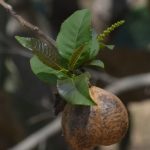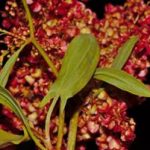TREE LIFE
March 2021
We are still confined to barracks!! That we are continuing to produce Tree Life, in its new format, is due to the efforts of Ryan Truscott, Mark Hyde, Ian Riddell and our chairman, Tony Alegria. We thank these gentlemen. I have not had to resort to past issues of Tree Life, although there is plenty of good reading there. If someone has something of interest to Tree Life readers please let Tony or me have it.
I made a remark on the new format of Tree Life, so far there has been no comment from our readers. Have you noticed it, Tree Life now appears as a single column, do you like it or not?
PALMS OF HARARE – 1
THE 9 MOST COMMON PALMS IN ALEXANDRA PARK
For the last 2 years, I have been taking daily walks around my home suburb of New Alexandra Park with two aims. One was to lose some weight and the other was to identify and record the planted trees to be found in the streets and those visible in the adjacent gardens. Sadly, the objective of losing weight has not been particularly successful but the study of the trees, which are a mixture of the native and exotic, has proved quite fascinating. The project has also fitted in well with the Covid-19 lockdowns and restrictions which have so limited travel in the past year.
One of the groups I had never looked at previously was palms. In this short article, I will describe briefly the most common palms which can easily be seen in the suburb. Nine species are involved which are as follows.
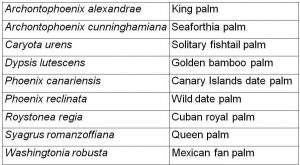
All but two species have 1-pinnate leaves. The exceptions are the Caryota which has 2-pinnate leaves and the Washingtonia with palmate leaves. All apart from Phoenix reclinata are non-native and there is even some debate about the status of that species.
Species of the genus Archontophoenix originate from Australia. The two species appear to be commonly planted; they have grey ringed trunks, at the apex of which is a long crown-shaft surmounted by the 1-pinnate leaves. The inflorescences emerge from the base of the crown-shaft and consist of a cluster of pendulous pale branches along which the flowers occur. The fruit are small and red.
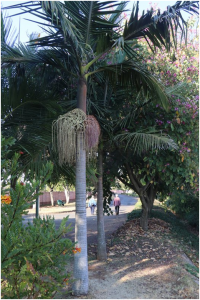
Archontophoenix cunninghamiana at Dandaro
Even now, I am still not sure I can confidently separate the two species. The books tell me there are three characters which serve to distinguish the two.
Key to the two Archontophoenix species
Trunk swollen at the base; leaflet under-surface greyish-white, not chaffy; flowers white or cream … alexandrae
Trunk scarcely swollen at the base; leaflet under-surface green, chaffy on the midvein; flowers lilac or purplish … cunninghamiana
However, the trunk character is a bit ambiguous, leaves are always out of reach and the palms are not always flowering, so this is not easy. As far as I can tell, both species seem to be common, but this is still to be confirmed.
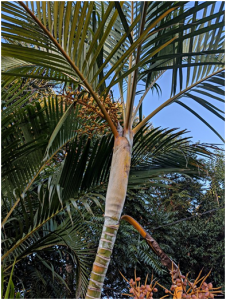
Dypsis lutescens, College Road
On to the Solitary fishtail palm, Caryota urens, a native of India and Sri Lanka. As mentioned earlier, these are the only palms with 2-pinnate leaves. The leaflets have a characteristic shape, somewhat resembling the tail of a fish. The English word ‘Solitary’ is used to separate the species from Caryota mitis, the Multi-stem fishtail palm.
Incidentally, the specific name urens meaning stinging and refers to oxalic acid crystals in the fruit which can irritate the skin if handled. C. urens is very commonly planted in streets and gardens and the 2-pinnate leaves make it easy to identify.
Dypsis lutescens, formerly known as, and still commonly referred to as, Chrysalidocarpus lutescens, is another very common palm, originating from Madagascar. It is usually relatively short with a slender trunk. The trunk is greenish with many prominent rings, perhaps giving rise to the common name of bamboo palm. As the specific name, which is derived from lutea, meaning yellow, suggests, various parts of this palm are yellow, in particular the base of each leaf and the top of the crown shaft the body of which is grey in colour. The leaves are 1-pinnate, large and wide-spreading giving the plant a graceful and attractive appearance.
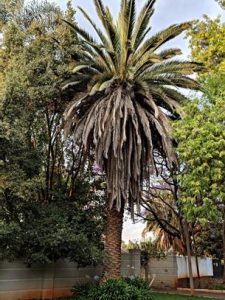
Phoenix canariensis, Carsberg Avenue
The next genus to be considered is another genus with 1-pinnate leaves, the lower leaflets are modified to sharp spines (acanthophylls) and the leaflets are V-shaped in cross-section. Phoenix canariensis is quite widespread in the suburb but there are not such large numbers of this species as in other palms. It is endemic to the Canary Islands off the NW coast of Africa. This very distinctive palm has a massive trunk, typically 75 -100 cm in diameter and bears long narrow leaves at the apex. The inflorescence is born on a flattened stalk and is often bright orange.
Better known to me was Phoenix reclinata. This is a widespread species in tropical and South Africa, Madagascar and the Arabian Peninsula. This is one of our few native palms and is well known from many areas of Zimbabwe but perhaps its most iconic location where it features on much tourist advertising is by the Zambezi River above the Victoria Falls. The question as to whether it is native to Harare is more difficult; it’s certainly not something you see in the surrounding non-built-up areas of the City and I suspect its presence is down to man. Whatever its origin, it is the most common palm in the city, often cultivated and also spreading naturally (by birds?) and cropping up everywhere on roadside verges and in gardens. In the wild, the stems are clustered, but it is often planted singly.
This is the only species of palm I have seen which spreads naturally.
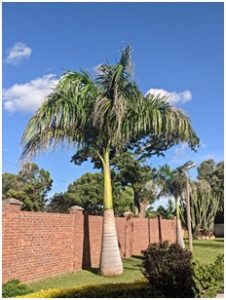
Roystonea regia, Crossland Road
On next to the Cuban Royal palm, Roystonea regia. It is not only found in Cuba, but also occurs in southern Florida, Mexico, Central America and the Caribbean.
This is a very popular species in cultivation, recognised by the markedly swollen base and the grey trunk bearing rings and supporting a long, prominent green crownshaft. It is frequently planted in gardens, streets and carparks.
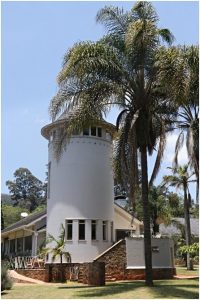
Syagrus romanzoffiana at La Rochelle
Syagrus romanzoffiana is also one of the most common palms in the city. It is native to South America.
It is a large palm without a crownshaft; its long leaves have leaflets borne in multiple planes on either side of the leaf and the inflorescences are borne within large woody boat-shaped bracts which persist on the tree and hang downwards.
The fruit are orange.
This is a splendid architectural plant and is commonly seen lining roadsides, as a guardian of entrance gates and planted en masse in car parks and other open areas. It was formerly known as Arecastrum romanzoffianum.
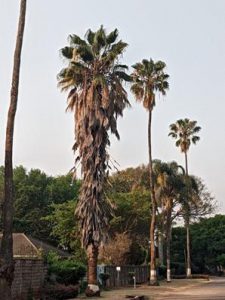
Washingtonia robusta – specimens with and without ‘skirts’
Finally, Washingtonia robusta. This is a desert palm form SW America and Mexico. This is very tall palm with a slender tapering trunk, the base being about twice as wide as the apex.
A skirt of dead leaves often clothes the stem from top to bottom or in many trees is completely absent. It appears that the presence of the skirt is not of taxonomic significance; the old leaves can be removed by the actions of the weather or by man for ornamental reasons.
At the apex of the trunk is a cluster of shiny green palmate leaves. This is very common and easily visible because of its height. This is the species that was planted in the 1920s along the central reservation of Julius Nyerere Way, many of which remain to this day.
I am most grateful to Tony Alegria and Clare Hingeston (the owner of Pleasure in Palms) for advice and assistance in getting to know the palms of Harare. If there is sufficient interest, I may continue with a second article on some of the less common palms of Harare.
-Mark Hyde
TREE OF THE MONTH — the long and short of Syzygium guineense
Each February there is a major event in our garden: the fruiting of the Woodland waterberry, Syzygium guineense subsp. guineense.

Ladder up the tree at harvest time. Photo: Ryan Truscott
The tree’s crop of burgundy berries become a magnet for birds.
Turacos, bulbuls and barbets come and feast on them and leave their purple droppings all over the place.
We prop a ladder against the tree trunk so that our daughter can clamber up and claim her share of the harvest.

A grey lourie came to sit next to me. Photo: Ryan Truscott
I also went up and, as if to enhance the experience, a Grey go-away-bird came and perched on a branch near to me.
I marvelled that a species of tree this size could adapt to growing underground.
I’m talking here of Syzygium guineense subsp. huillense: an underground form of my garden waterberry that grows barely higher than my ankles.
I first came across these ‘trees’ on a visit to Harare’s Haka Park in October.
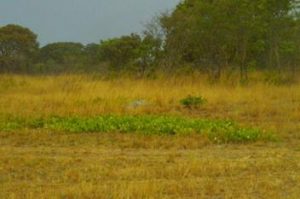
Bright green patch of dwarf water berry. Photo : Ryan Truscott

Purple fruit of woodland water berry. Photo: Ryan Truscott
Also known as Dwarf waterberries, they formed eye-catching green patches against the baked yellow ground and were flowering with the ‘shaving-brush’ blossoms typical of the genus.
This month I noticed that they had produced their own crop of large purple fruit, though not nearly as palatable as the ones on my tree.
At this time of the year parts of Haka’s grasslands, one of seven wetlands protected in Zimbabwe under the Ramsar Convention, are as soggy as a wet sponge.
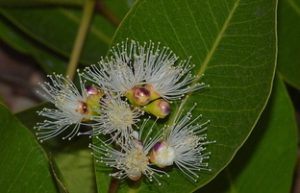
“Shaving brush” blossom of drawf water berry. Photo: Ryan Truscott
If waterberry trees did try to grow there in the conventional way they would surely topple over.
But scientists say the suffrutex forms of common woodland species, also known as geoxylic suffrutices are an adaptation to an array of environmental pressures.
If it were just inundation the trees were adapting to, they would possess traits such as the spongy aerated tissue found inside water-lilies.
But a study done on the rootstocks of four common suffrutex species did not provide any evidence of this tissue or other adaptations to inundation, note the authors of a paper on suffrutex ecosystems published in a recent book, Biodiversity of Angola.
“So far the main environmental driver for the astonishing radiation of geoxylic suffrutices has not been conclusively identified,” the authors stated.
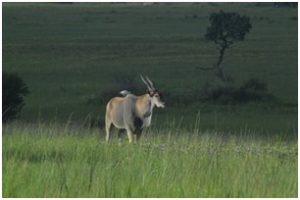
Haka Park is now a sea of grass. Photo: Ryan Truscott
Interestingly, they did note that some suffrutex trees do grow out of their dwarf state if they are protected from “environmental stressors”.
Incidentally, I have found dwarf forms of the Mobola plum, Parinari curatellifolia growing in the middle of Haka’s grasslands. Yet in the wooded and well-drained areas, which are presumably also sheltered from fire and frost, the Mobola plums grow tall and proud.
In southern Africa the close-relatedness of these different forms of Syzygium guineense has long been understood, as seen by the similar names used to refer to them in local languages.
In Zimbabwe, the dwarf form of S. guineense is known in Shona as Mukute-pasi; the tree like the one in my garden as Mukute-bango. In Angola the dwarf form is known to the Chokwe people as Mupaua, and the tree as Muhaua.
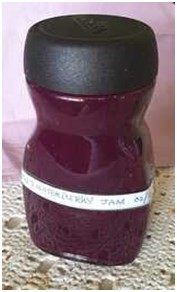
Waterberry trees make lovely jam. Photo: Carol Smith
Back in Haka Park, the suffrutex trees have now been swallowed up by the sea of summer grasses. In October I’ll go back to see their emerald green leaves once more shining bright against the subdued earth.
In the meantime, I’ll enjoy the sweet fruits of their woodland cousin. Perhaps I’ll even collect some for our friend Carol, whose Mum makes all kinds of jam.
“Waterberry jam is the most beautiful colour!” says Carol. And she sent me a picture to prove it.
-Ryan Truscott
The Fern-leaf as a garden plant
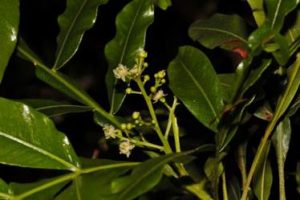
Flowers and buds
The Fern-leaf Filicium decipiens is an evergreen eastern highlands forest tree that can get large – up to 25 m, but they may not get that big in Harare. We have a fairly big one in ‘the grove’ that, when fruiting, attracts the fruit-eating birds and this makes it a good garden subject. Even without the added bonus of fruit it is an attractive tree – the fern-like glossy compound leaf has a winged rachis and wavy margins, which is unusual in itself and makes it a striking tree.
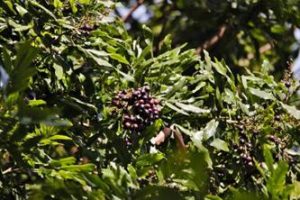
Fruit in Tree. Photo: Ian Riddell
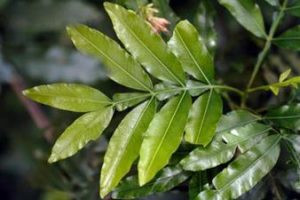
Leaves. Photo: Ian Riddell
The Fern-leaf belongs to the Sapindaceae and on the highveld we are more au fait with other members of the family like the Velvet-fruit Zanha Zanha africana and the Sand Olive Dodonaea viscosa. In Harare, it is quite late flowering and the fruits appear in April. The flower is small and insignificant but the purple drupe, up to a centimetre long, is
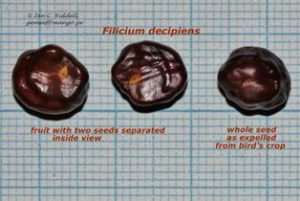
Seeds. Photo: Ian Riddell
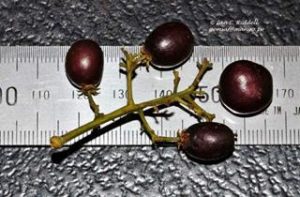
Fruit. Photo: Ian Riddell
conspicuous enough. They certainly are to the barbets, bulbuls and turacos and expelled seeds and fruit can be picked up off the drive and readily germinate under the tree.
-Ian Riddell Email: gemsaf@mango.zw
Is that tree a Munondo or a Musasa?
It’s a fact, many people do not know the difference between a Munondo tree or a Musasa tree perhaps besides the fact that they can be written in different ways e.g. Mnondo, Msasa. We were once invited to go to a property in Ruwa to identify trees and were told that they had many, many Musasa trees. Well, we went to this plot and identified more than forty species of trees and guess what? Not a single Musasa tree was seen but, the property had loads and loads of Munondos!
So, what’s the problem? Well it’s because they look so alike, that is till you get down to the nitty gritty! In fact not so nitty gritty as there are some obvious differences enabling you to readily identify most of them as you drive past them! They both shed their leaves and get new reddish leaves at roughly the same time, once a year. The Msasas in Nyanga, on the way up to Troutbeck, that are stunted are different in that new leaves are very dark – almost black. Why this is so, I have no idea! Leaves have these reddish (pink to intense red) colours because they have built in sun tan lotion (called Anthocyanin) to protect the young, tender leaves against the sun. Once the leaves are hardy enough to withstand full sunlight, they will then go through several shades of green till they attain their normal dark green leaf colouration. There are a few other species of trees that have anthocyanin consequently their new young leaves have that reddish look.
The Munondo, Julbernardia globiflora is the only species in Zimbabwe in the genus Julbernardia. The genus is named after Jules Bernard, former governor of Gabon whilst the species, globiflora means spherical (like a globe) flowers. The Musasa, Brachystegia spiciformis is one of 8 species within the genus Brachystegia. Other well known Brachystegias are the B. boehmii. Prince-of-Wales’ feathers or Mfuti and B. tamarindoides (old name B. glaucescens), Mountain acacia. The genus Brachystegia means “short roof or covering” – the buds are protected by a pair of bracteoles whilst the species spiciformis means resembling a spike, presumably referring to the inflorescence. The main differences between the Munondo and the Musasa are the leaves, pods and flowers. For more differences and other information, consult the “Guru” book – Keith Coates Palgrave TREES of Southern Africa which has been revised and updated by Meg Coates Palgrave.

Munondo leaves. Photo: Tony Alegria

Musasa Leaves. Photo: Tony Alegria
The Musasa leaf typically has 3 or 4 pairs of leaflets on the highveld with the leaflets becoming bigger and bigger towards the end. Strangely enough, in the eastern highlands, they have many more pairs of leaflets. They are quite shiny and wave in the breeze. On the other hand, the Munondo leaf has about twice as many pairs of leaflets with the biggest being near the centre. They are a lot duller than the Musasa leaflets and the above photo shows a younger leaf found growing amongst darker, mature leaves.

Munondo pods. Photo: Bart Wursten. Flora of Zimbabwe

Musasa pods. Photo: Bart Wursten. Flora of Zimbabwe
The Musasa pods are green whilst young and can be found anywhere on the tree amongst the foliage. The Munondo pods are roughly half the size, are brown and positioned above the foliage on top of the tree and bigger branches. This feature is very obvious!
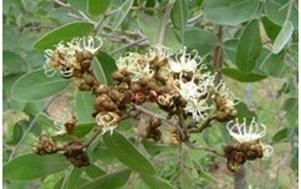
Munondo flowers. Photo: Flora of Zimbabwe
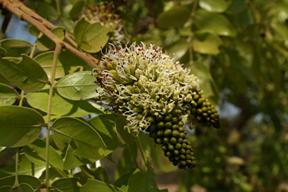
Musasa flowers. Photo: Mark Hyde. Flora of Zimbabwe
The Musasa flowers are on a spike and are sweetly scented and appear from August to November. I’m told that Musasa honey is to die for! As can be seen, the Munondo flowers are individual and spherically shaped. The Munondo flowers from January to May – so a completely different time of the year.

A Big Musasa Tree Photo by Tony Alegria
Generally old Musasa trees are bigger than the Munondos and although I have seen many good looking Musasa trees, I’m yet to see a really good Munondo!
-Tony Alegria.
TONY ALEGRIA, CHAIRMAN


